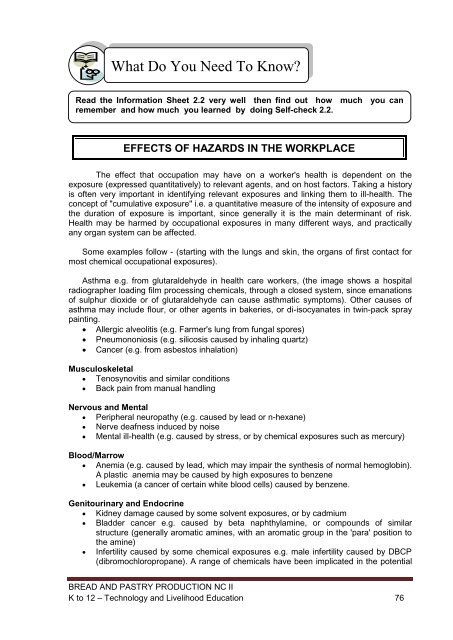BREAD AND PASTRY PRODUCTION - Kapitolyo High School
BREAD AND PASTRY PRODUCTION - Kapitolyo High School
BREAD AND PASTRY PRODUCTION - Kapitolyo High School
You also want an ePaper? Increase the reach of your titles
YUMPU automatically turns print PDFs into web optimized ePapers that Google loves.
The effect that occupation may have on a worker's health is dependent on the<br />
exposure (expressed quantitatively) to relevant agents, and on host factors. Taking a history<br />
is often very important in identifying relevant exposures and linking them to ill-health. The<br />
concept of "cumulative exposure" i.e. a quantitative measure of the intensity of exposure and<br />
the duration of exposure is important, since generally it is the main determinant of risk.<br />
Health may be harmed by occupational exposures in many different ways, and practically<br />
any organ system can be affected.<br />
Some examples follow - (starting with the lungs and skin, the organs of first contact for<br />
most chemical occupational exposures).<br />
Asthma e.g. from glutaraldehyde in health care workers, (the image shows a hospital<br />
radiographer loading film processing chemicals, through a closed system, since emanations<br />
of sulphur dioxide or of glutaraldehyde can cause asthmatic symptoms). Other causes of<br />
asthma may include flour, or other agents in bakeries, or di-isocyanates in twin-pack spray<br />
painting.<br />
Allergic alveolitis (e.g. Farmer's lung from fungal spores)<br />
Pneumononiosis (e.g. silicosis caused by inhaling quartz)<br />
Cancer (e.g. from asbestos inhalation)<br />
Musculoskeletal<br />
Tenosynovitis and similar conditions<br />
Back pain from manual handling<br />
Nervous and Mental<br />
Peripheral neuropathy (e.g. caused by lead or n-hexane)<br />
Nerve deafness induced by noise<br />
Mental ill-health (e.g. caused by stress, or by chemical exposures such as mercury)<br />
Blood/Marrow<br />
Anemia (e.g. caused by lead, which may impair the synthesis of normal hemoglobin).<br />
A plastic anemia may be caused by high exposures to benzene<br />
Leukemia (a cancer of certain white blood cells) caused by benzene.<br />
Genitourinary and Endocrine<br />
Kidney damage caused by some solvent exposures, or by cadmium<br />
Bladder cancer e.g. caused by beta naphthylamine, or compounds of similar<br />
structure (generally aromatic amines, with an aromatic group in the 'para' position to<br />
the amine)<br />
Infertility caused by some chemical exposures e.g. male infertility caused by DBCP<br />
(dibromochloropropane). A range of chemicals have been implicated in the potential<br />
<strong>BREAD</strong> <strong>AND</strong> <strong>PASTRY</strong> <strong>PRODUCTION</strong> NC II<br />
K to 12 – Technology and Livelihood Education 76<br />
76<br />
What Do You Need To Know?<br />
Read the Information Sheet 2.2 very well then find out how much you can<br />
remember and how much you learned by doing Self-check 2.2.<br />
EFFECTS OF HAZARDS IN THE WORKPLACE


